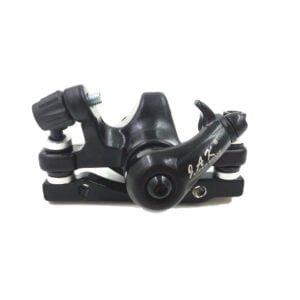Manual use of DUCATI CROSS-E Scooter and Error Code

The Ducati CROSS E electric scooter, with Scrambler Ducati branding, is fitted with so-called tubeless puncture-proof tires (size 110/50-6.5″), which are also suitable for dirt tracks or very uneven roads.
The brushless motor provides a continuous power of 500W and guarantees an excellent start both at the start and on the uphill sections, without any slowing down of the pace.
The 375 Wh battery guarantees a range of up to 40 km (25 miles), while maintaining an average speed of 15 km/h (9 mph). The robustness, also visually, of the frame provides maximum stability and riding comfort.
The dual headlights allow the vehicle to be used at night with excellent visibility and the management of all functions, including the 3 driving modes, is done through the large 3.5″ LCD display.
Ducati Cross-E data sheet
500W brushless motor
Low voltage protection 31V+/-0.5V
Current limit 23A
Maximum load 120kg
Battery 48V 10.4 Ah 499 Wh
DC 2.1 charger
110/50-6.5″ tubeless tires front and rear
Ducati CROSS-E Controls/Control Panel Information
- Speedometer: displays real-time speed of the electric scooter and error codes
- Battery level: battery level indicated by 7 bars
- ODO: shows the total distance
- TRIP: shows the distance of each session
- Indicates that the scooter’s headlights are switched on
- SPORT mode: indicates sport mode (maximum speed 25 km/h)
- Mode D: indicates comfort mode (maximum speed of 15 km/h)
- ECO mode: indicates the energy saving mode (maximum speed 6 km/h)
- Cruise Control: indicates that the cruise control function is active
Controls information:
– Power button (B): press and hold this button to turn the electric scooter on/off.
– Accelerator (A): use it to start the electric scooter and accelerate.
– Brake (C): press and hold to brake.
– Mode: press button (B) twice to select the mode.
– Headlight and tail light: press button (B) once to turn it on. When the lights are on, press button (B) again to turn them off.

Adjustment of Ducati CROSS-E brakes

Brake levers If necessary, the position of the brake lever can be adjusted through point A (see photo).

Brake caliper adjustment Use points B and C to align the brake caliper with the disc (see photo). To adjust the brake travel, use point D.
Scooter autonomy
Storage and cleaning
Up to 45 km (subject to variations depending on driver’s weight, road conditions and temperature)
Maximum range depends on several variables: Terrain: driving on smooth pavement means greater range than driving on uneven and hilly roads. User weight: the heavier the user, the lower the autonomy. Temperature: driving the scooter in a very cold or very hot environment affects the autonomy. Speed and driving style: smooth and constant driving extends the range.
Accelerations and abrupt maneuvers significantly reduce range. A low speed extends the autonomy. If the electric scooter does not cover at least 60% of the declared km or reach the maximum speed within the first 3 months of use, it is likely that the tires have deflated and the pressure must be restored to the indicated value (2.5 bar).
Charge the electric scooter between 50 % and 60 % before taking it out of service for a season or for extended periods of time. Recharge to 50% – 60% every 2 to 3 months. If not used daily, it is recommended to store the electric scooter at 15-25 °C. Do not expose the electric scooter to very low temperatures (below 0 °C) or very high temperatures (above 45 °C). Avoid leaving it outdoors, as it is not water resistant.
When the electric scooter gets dirty, wipe it with a damp cloth. Before cleaning, make sure that the electric scooter is turned off and cover the charging port to prevent damage to the electronic components. Do not use alcohol, gas, kerosene or other corrosive and volatile chemical solvents. This could damage both the appearance and the internal structure of the electric scooter. Do not use pressurized water guns or running water for cleaning.
The electric scooter is not waterproof. Do not expose to rain or water, immerse or wash with water.
Ducati CROSS-E Battery
(Warnings)
Make sure the scooter, charger and charging port are dry.
When the scooter is fully charged, the LED light on the charger changes from red (charging) to green (charging complete).
Use only the original charger. Other chargers damage the device and pose other potential risks.
The scooter should not be charged for prolonged periods of time. Overcharging reduces battery life and may cause other potential hazards.
Load the scooter in a dry environment away from flammable materials (e.g. materials that can burst into flames), preferably at an internal temperature of 15-25 °C, but never below 0 °C and never above + 45 °C.
Do not charge in direct sunlight or near fire. Do not charge the scooter immediately after use. Allow the scooter to cool down for one hour before charging.
Never leave the electric scooter unattended while charging. Risk of heat! Never connect the DC charging socket with metallic objects.
Read the charging and storage sections above to ensure proper battery maintenance and handling. Keep the scooter away from open flames or other heat sources to prevent the battery from overheating. Do not leave the scooter exposed to freezing temperatures. Both excessive heat and cold can drain the battery.
Avoid discharging the battery completely.
It is best to recharge the battery when it still has some charge. This prolongs battery life. When the load is too low, normal driving is not possible. This can cause the driver to lose control or fall.
Ensure that the battery is charged at regular intervals, even if you do not use the electric scooter for an extended period of time. This prevents damage to the battery caused by low voltage over a long period of time.
Battery precautions

The battery is composed of lithium-ion cells and chemical elements hazardous to health and the environment. Do not use the scooter if it emits odors, substances or excessive heat. Do not dispose of the electric scooter or battery with household waste.

Cleaning and storage of Ducati CROSS-E
If there are stains on the body of the scooter, wipe them off with a damp cloth. If stains persist, put toothpaste on them, brush with a toothbrush and then wipe with a damp cloth. If there are scratches on the plastic components, use sandpaper or other abrasive material to remove them. Notes: Do not clean the scooter with alcohol, gasoline, kerosene or other corrosive and volatile chemical solvents to avoid serious damage. Do not wash the scooter with high-pressure water jets. When cleaning the scooter, make sure it is turned off, the charging cable disconnected and the rubber cap closed, as water leakage could cause an electric shock or other serious problems. When the scooter is not in use, store it in a cool, dry place. Do not store outdoors for a prolonged period of time. Excessive sunlight, overheating and excessive cold accelerate tire aging and compromise the life of the scooter and battery.
Check the brakes and that they are correctly adjusted.
Check the screws in general
- Do not use batteries of other models or brands, as they may pose a safety risk.
- Do not disassemble, crush or puncture the product. Do not touch the battery contacts. Do not disassemble or drill holes in the outer casing. Avoid contact with water and fire and do not expose the product to temperatures above 50 °C (including heat sources such as stoves, heaters, etc.). Avoid contact of metallic objects with the battery contacts to prevent short circuits, physical injury or death.
- Water leaking into the battery may cause damage to the internal circuits and risk of fire or explosion. If you have any doubt that water may have entered the battery, stop using it immediately and take it to your dealer’s after-sales service for inspection.
- Use only the original charger to avoid potential damage or fire.
- Improper disposal of used batteries seriously pollutes the environment. Follow local regulations regarding battery disposal. Follow battery disposal regulations to protect the environment.
- After each use, fully recharge the battery to prolong its life. Do not store the battery in an environment where the temperature is above 50 °C or below -20 °C (for example, do not leave the scooter or battery in a car in direct sunlight for an extended period of time). Do not dispose of the battery in fire, as this may cause failure, overheating and even fire. If you do not plan to use the scooter for more than 30 days, recharge the battery to 50/60% and store it in a cool, dry place. Remember to recharge it every 60 days to protect it from damage excluded from the limited warranty. Always recharge the battery before it runs out of power to prolong its life.
Ducati CROSS-E data sheet
500W brushless motor
Low voltage protection 31V+/-0.5V
Current limit 23A
Maximum load 120kg
Battery 48V 10.4 Ah 499 Wh
DC2.1 charger
110/50-6.5″ tubeless tires front and rear
Ducati CROSS-E error codes
E.1 Motor malfunction
E.2 Communicationerror–controller kit48V
E.3 Incorrect operation of the throttle lever
E.4 Malfunction of the controller-kitcontroller 48V
E.5 Low voltage protection
E.6 Incorrect operation of the brake lever

Problems and solutions of Ducati CROSS-E
Question: Motor is not running
Battery is discharged/Electrical problem
Battery not connected (Check connectors)
Question: Rear wheel does not turn
Brake problem
Adjust the brakes
Question: Motor shuts off when running
Engine overheating
Release the throttle and wait for it to cool down.
Question: After charging, the vehicle shuts down.
Battery is damaged
Question: The vehicle stops suddenly while in motion.
Damaged power and control cables
Question: The battery does not charge or the scooter does not turn on.
Connection problems
2. Battery damaged/dropped out
3. Problems with the charger




